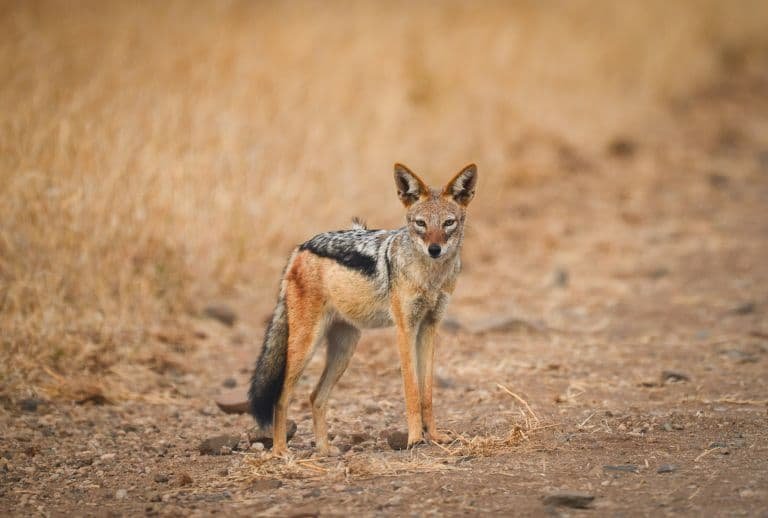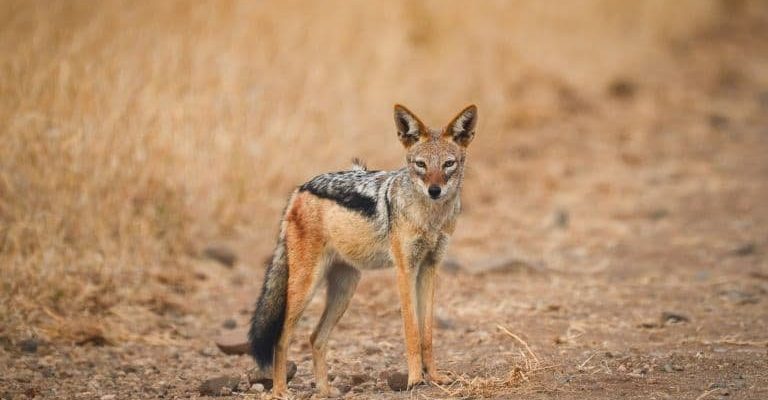
Jackals belong to the family Canidae, which includes animals like dogs and coyotes. You can find them scattered across Africa, Asia, and even parts of Europe. They’re not just interesting for their habitats or how they look; their behaviors and social structures are equally captivating. So, let’s explore ten fascinating facts about jackals that will make you appreciate these clever canines even more!
1. Three Distinct Species of Jackal
There are actually three main types of jackals: the golden jackal, the side-striped jackal, and the black-backed jackal. Each species has its own unique traits and habitats:
- Golden Jackal: Found in parts of Africa, the Middle East, and South Asia, the golden jackal is adaptable and thrives in diverse environments.
- Side-Striped Jackal: As the name suggests, this species has distinct stripes on its sides. It primarily lives in wooded areas and is mostly found in southern Africa.
- Black-Backed Jackal: This one is most recognizable due to its black back and is often seen in more open plains and savanna regions of eastern and southern Africa.
Believe it or not, the golden jackal was once believed to be a transitional form between wolves and dogs. This reflects their adaptability, as they can easily change their diet and lifestyle depending on their environment.
2. Smart and Social Animals
Honestly, one of the most intriguing things about jackals is their intelligence. They are social creatures that often live in small family groups. Think of them as the “squad” of the animal kingdom. They communicate through various vocalizations, body language, and even facial expressions.
Jackals have a knack for teamwork, especially when it comes to hunting. They will often work together to take down prey larger than themselves. For example, a pack might surround a herd of antelope, using their numbers to outsmart their target. This social structure not only helps them hunt effectively but also strengthens family bonds within the group.
You might be wondering how they maintain hierarchy within the pack. Typically, there is a dominant breeding pair, and the other members help raise the pups. This cooperative care not only helps the young jackals survive but also fosters a strong family unit.
3. Excellent Adaptability
Here’s the thing about jackals: they’re incredibly adaptable. They can thrive in various habitats, from dry deserts to lush grasslands. This adaptability extends to their diet as well. Jackals are omnivorous, which means they eat a little bit of everything, including fruits, insects, small mammals, and carrion.
For instance, if a jackal finds a dead animal, it won’t hesitate to scavenge and get a meal. They are also known to raid farms for livestock, which sometimes puts them at odds with humans. This ability to eat what’s available often gives jackals a leg up in survival, especially in changing environments.
Whether it’s a hunt or a scavenging session, their resourcefulness is key to their success in the wild. Imagine having that kind of skill set in your everyday life!
4. Unique Vocalizations
Jackals have a fascinating way of communicating. They use a variety of vocalizations, including barks, howls, and yips, which can sound like a mix of a dog and a wolf. Their calls can travel long distances, which is particularly useful for keeping in touch with pack members or marking territory.
A notable behavior is their *howling*, which they often do at dusk and dawn. This can create a hauntingly beautiful symphony if you’re out in the wild. It’s not just for show; it helps establish their presence and can deter other predators from entering their territory.
Imagine being in the quiet savanna at sunset, hearing the distant calls of a jackal pack. It’s a reminder of the wildness of nature and the intricate social lives of these amazing creatures.
5. Jackals and the Ecosystem
Jackals play a vital role in their ecosystems. As both predators and scavengers, they help maintain balance within their habitats. By keeping certain animal populations in check, they ensure that no species dominates the environment.
When jackals scavenge, they also help clean up the landscape. By eating dead animals, they prevent the spread of disease and contribute to a healthier ecosystem. It’s a win-win situation: they get food, and the environment benefits too.
You might not think much about these creatures when discussing wildlife conservation, but every little bit helps. Protecting their habitats is essential not only for their survival but for the overall health of the ecosystems they inhabit.
6. Reproduction and Life Cycle
Jackals have a unique breeding season, typically occurring once a year. After a gestation period of about 60 days, the female jackal gives birth to a litter of 2 to 6 pups. These pups are born blind and rely heavily on their parents for protection and nourishment.
The fascinating part? Unlike many animals, jackal pups are raised by the entire family group. The parents, alongside other pack members, provide care and teaching. This family-oriented approach not only helps the young ones survive but also equips them with essential skills for hunting and living in the wild.
Pup rearing is a demanding task, but it’s rewarding. Watching them grow and learn is an amazing sight for anyone fortunate enough to observe it in nature.
7. Jackals and Humans
Historically, jackals have had a complicated relationship with humans. In some cultures, they’re viewed as symbols of cunning and trickery, while in others, they’re often seen as pests due to their predation on livestock.
These encounters can lead to conflicts, especially when farmers and herders feel threatened by jackals’ raids. However, it’s important to recognize their ecological role. Rather than seeing them solely as nuisances, understanding their behavior can help humans coexist with these beautiful animals.
In some regions, conservation efforts are focusing on finding ways to protect jackals while minimizing their impact on agriculture. This might include strategies like using guard animals or implementing better fencing techniques. It’s a delicate balance, but worth exploring for a sustainable coexistence.
8. Jackal Hunting Strategies
When it comes to hunting, jackals have a repertoire of clever strategies. They exhibit a mix of solitary and pack hunting. Depending on the situation, they might hunt alone or collaborate with pack members for larger prey.
For example, when hunting small mammals like rodents, a jackal might rely on stealth and speed, pouncing on its target. In contrast, when hunting larger prey, they can strategically work together to corral the animals into a confined space, making the hunt more manageable.
Their intelligence shines through in these tactics. Jackals are not just brute force; they think creatively about how to approach their meals. It’s like a game of chess for them, where every move counts.
9. Cultural Significance
Across various cultures, jackals are often portrayed in folklore and mythology. In some African cultures, they are seen as symbols of cleverness and adaptability, while in ancient Egyptian mythology, the god Anubis was depicted with a jackal’s head. This connection reflects humans’ long-standing fascination with these creatures.
In storytelling, jackals are often characterized as tricksters, emphasizing their cunning nature. This portrayal not only entertains but also teaches lessons about wit and survival. It’s fascinating how these animals have woven themselves into our cultural narratives.
Additionally, understanding these cultural significances can help foster greater respect and appreciation for jackals, encouraging conservation efforts.
10. Conservation Status of Jackals
Despite being adaptable, jackals face several threats, primarily from habitat loss and human encroachment. While they are not currently endangered, certain populations are at risk due to overhunting and habitat destruction.
Conservation efforts are essential for ensuring a stable future for jackals. Educating the public about their ecological importance and promoting coexistence strategies can help mitigate human-wildlife conflict.
Various organizations are working tirelessly to protect these creatures and their habitats. It’s important to support these initiatives, as preserving jackals contributes to the health of entire ecosystems.
In conclusion, jackals are much more than ordinary canines. They embody resilience and intelligence, playing vital roles in their ecosystems. By understanding and appreciating these fascinating creatures, we can help ensure that they continue to thrive for generations to come. So next time you hear about jackals, remember just how extraordinary they truly are!

